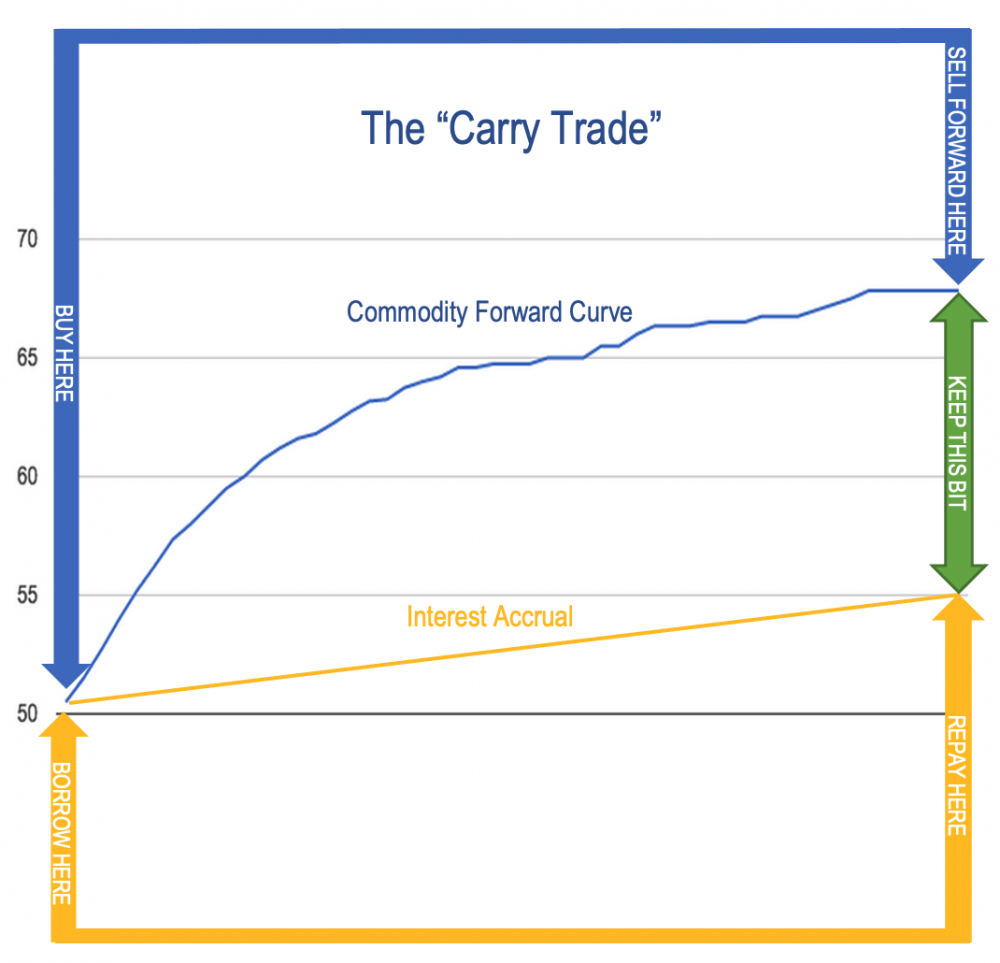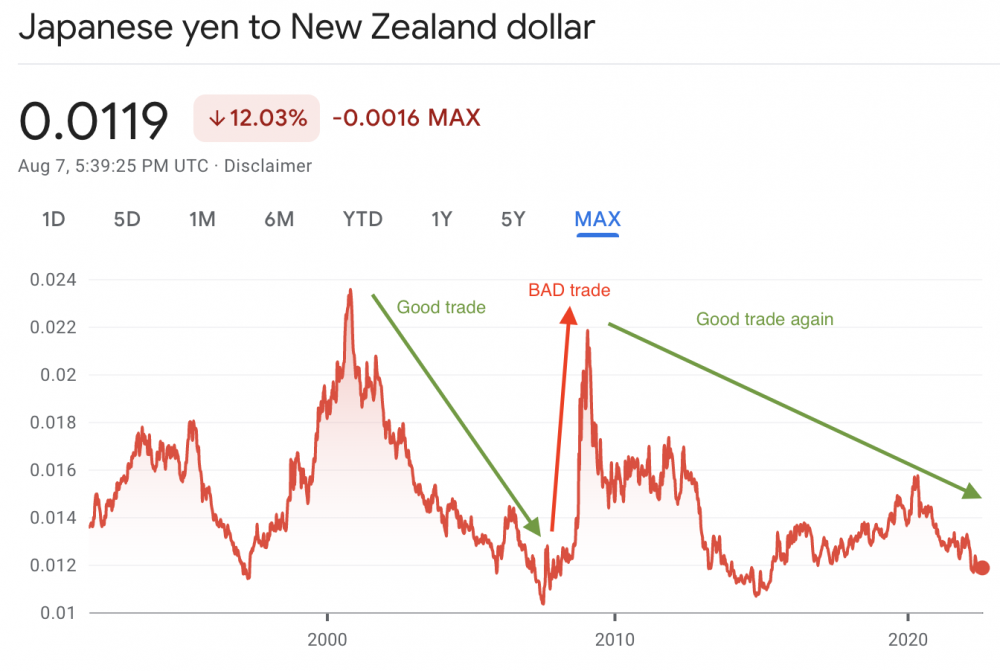Carry trade: Difference between revisions
Amwelladmin (talk | contribs) Created page with "{{a|g|{{image¬carry trade|png|A classic commodities carry trade, yesterday. You execute the spot buy and the forward sale at the same time.}}}}A transaction where one tak..." |
Amwelladmin (talk | contribs) No edit summary |
||
| (14 intermediate revisions by the same user not shown) | |||
| Line 1: | Line 1: | ||
{{a|g|{{ | {{a|g|{{image|carry trade|png|A classic commodities [[carry trade]], yesterday. You execute the spot purchase and the forward sale at the same time.}} | ||
{{image|yen carry|png|The yen carry trade, then and now.}} | |||
}}{{quote| | |||
''Carry doesn’t live here anymore <br> | |||
''Carry used to price at flat [[LIBOR]] <br> | |||
''Sorry that she left no [[forward]] address <br> | |||
''Because her main financing was in distress. | |||
:—Riff Clichard, ''Carry'' (1982, needless to say, a time of usurious interest rates)}} | |||
If you can see that the spot price of an asset today is lower than its forward price (as implied by the futures price) — that is, the forward curve is in [[contango]] — | {{d|Carry trade|/ˈkæri treɪd/|n|}} | ||
A transaction where one takes advantage of the market’s ''present'' opinion about its own future — most commonly expressed through the prism of the [[futures]] market — where that opinion is that an asset’s price will rise at a rate greater than one can borrow the cash required to buy it. | |||
“[[Positive carry]]” describes the state of affairs when the the implied cost of financing an asset, as well as actual costs of [[Custody|holding]] it and ensuring — ''in''suring — you don’t lose is less that the rate at which the asset appreciates. This means you can do a “carry trade”: borrow money to buy the asset now, immediately arrange to sell it at its forward price later, hold the asset for its term, and pay down your loan with the sale proceeds you receive at the end. | |||
===Yen carry trade=== | |||
Hence, the famous “[[yen carry trade]]”, in fashion in that period in the noughties where ¥ interest rates were low or even negative, and, for example, New Zealand Dollar interest rates were around seven percent. Since the kiwi was not depreciating against JPY at 7 percent per annum, good money could be had by borrowing yen and buying [[kiwi]]. This was a good trade ''as long as the JPY/NZD exchange rate didn’t tank. During 2000 and 2007, not only did the kiwi not tank against the yen but, to the contrary the yen tanked against the Kiwi, largely because so many people were borrowing Yen and selling it to buy [[Kiwi]]. So not only did you lock in a 7% interest rate for the best part of a decade, you only had to pay back half of the principal you borrowed in the first place. When the Yen then rallied 98% in the next 18 months, a few people might have taken a bath. Things got back to normal, but the boring old [[New Zealand|kiwis]] stopped having such juicy high interest rates, so it’s not such a cool trade any more. | |||
===The hedged carry trade=== | |||
If you can see that the spot price of an asset today is lower than its forward price (as implied by the futures price) — that is, the forward curve is in “[[contango]]” — by an amount greater than your [[cost of funding]], then all you have to do to make money is | |||
#Today, borrow the money you need to buy the spot asset at your cost of funding for a term until your desired point in the future | #Today, borrow the money you need to buy the spot asset at your cost of funding for a term until your desired point in the future | ||
#Today, buy the asset in the spot market at its spot price; | #Today, buy the asset in the spot market at its spot price; | ||
| Line 14: | Line 31: | ||
#You have to pay the costs of holding it, so don’t forget those | #You have to pay the costs of holding it, so don’t forget those | ||
#The person to whom you sold it forward may have blown up in the meantime (but hopefully you’ll be taking margin from them so less of a bother). | #The person to whom you sold it forward may have blown up in the meantime (but hopefully you’ll be taking margin from them so less of a bother). | ||
#Don’t forget to make sure the forward curve is in fact in [[contango]], and the yield exceeds your cost of funding. Schoolboy errors, but these do happen. | |||
Happy days! | Happy days! | ||
{{sa}} | |||
*[[Contango]] | |||
*[[New Zealand dollar]] | |||
Latest revision as of 17:54, 7 August 2022
|
Carry doesn’t live here anymore
Carry used to price at flat LIBOR
Sorry that she left no forward address
Because her main financing was in distress.
- —Riff Clichard, Carry (1982, needless to say, a time of usurious interest rates)
Carry trade
/ˈkæri treɪd/ (n.)
A transaction where one takes advantage of the market’s present opinion about its own future — most commonly expressed through the prism of the futures market — where that opinion is that an asset’s price will rise at a rate greater than one can borrow the cash required to buy it.
“Positive carry” describes the state of affairs when the the implied cost of financing an asset, as well as actual costs of holding it and ensuring — insuring — you don’t lose is less that the rate at which the asset appreciates. This means you can do a “carry trade”: borrow money to buy the asset now, immediately arrange to sell it at its forward price later, hold the asset for its term, and pay down your loan with the sale proceeds you receive at the end.
Yen carry trade
Hence, the famous “yen carry trade”, in fashion in that period in the noughties where ¥ interest rates were low or even negative, and, for example, New Zealand Dollar interest rates were around seven percent. Since the kiwi was not depreciating against JPY at 7 percent per annum, good money could be had by borrowing yen and buying kiwi. This was a good trade as long as the JPY/NZD exchange rate didn’t tank. During 2000 and 2007, not only did the kiwi not tank against the yen but, to the contrary the yen tanked against the Kiwi, largely because so many people were borrowing Yen and selling it to buy Kiwi. So not only did you lock in a 7% interest rate for the best part of a decade, you only had to pay back half of the principal you borrowed in the first place. When the Yen then rallied 98% in the next 18 months, a few people might have taken a bath. Things got back to normal, but the boring old kiwis stopped having such juicy high interest rates, so it’s not such a cool trade any more.
The hedged carry trade
If you can see that the spot price of an asset today is lower than its forward price (as implied by the futures price) — that is, the forward curve is in “contango” — by an amount greater than your cost of funding, then all you have to do to make money is
- Today, borrow the money you need to buy the spot asset at your cost of funding for a term until your desired point in the future
- Today, buy the asset in the spot market at its spot price;
- Today, agree to sell it forward at that point in the future when your term funding matures, at its forward price
Then, just sit on the asset and wait. When the point in the future comes:
- On expiry, deliver the asset against payment of the agreed forward price (which may or may not be the prevailing spot price)
- On expiry, from the proceeds of your sale, repay principal and interest on the loan you borrowed in step 1.
- Keep the rest.
Works with any asset that has an observable forward market. Things that can go wrong:
- Your asset can go off, get lost, or be nicked (especially if a commodity in some warehouse in the Sudan)
- You have to pay the costs of holding it, so don’t forget those
- The person to whom you sold it forward may have blown up in the meantime (but hopefully you’ll be taking margin from them so less of a bother).
- Don’t forget to make sure the forward curve is in fact in contango, and the yield exceeds your cost of funding. Schoolboy errors, but these do happen.
Happy days!

